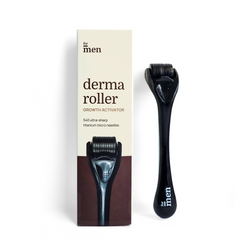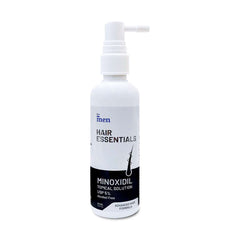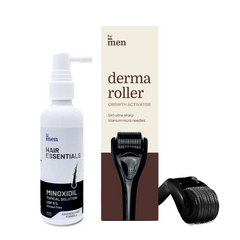What is High Porosity Hair?
Evidence Based
All the information in this blog post is accurate, trustworthy, scientifically based and has been written and fact-checked by our experts and doctors.
Our licensed nutritionists and dietitians are committed to being objective, unbiased and honest, presenting all sides of the argument.
This article includes scientific references in brackets, which are clickable links to research papers from reputable academic organizations.

Your hair type is the foundation of your hair care routine. While most of us focus on whether our hair is oily or dry, another crucial factor often goes unnoticed—hair porosity. Hair porosity is a game-changer in understanding how your hair absorbs and retains moisture, determining the effectiveness of your hair care products.
In this blog, we’ll take a closer look at high-porosity hair—its characteristics, how to identify it, and the best ways to care for it.
What is High Porosity Hair?
High porosity hair refers to strands with a compromised cuticle layer. The cuticles, which are the outermost protective layers of the hair shaft, are raised or damaged, creating gaps. These gaps allow moisture and products to penetrate easily but also lead to rapid moisture loss. As a result, hair may feel dry, brittle, and prone to damage.
High porosity hair is often the result of external damage but can also be a natural hair characteristic for some individuals.
What are the Signs of High Porosity Hair?
If you’re wondering whether your hair falls into this category, here are the common signs:
1. Rapid Absorption and Loss of Moisture:
Your hair absorbs water and products quickly but dries out just as fast, leaving it parched and frizzy.
2. Frizz and Tangling:
Open cuticles make your hair strands prone to tangling. Frizz and flyaways are also frequent, even with regular conditioning.
3. Brittle and Weak Hair:
Hair feels rough to the touch, breaks easily, and lacks elasticity. Split ends and breakage are common.
4. Lack of Shine:
High porosity hair often looks dull because raised cuticles scatter light instead of reflecting it.
5. Difficulty Retaining Hair Color:
If you dye your hair, the color fades faster due to the inability of the cuticles to lock pigments in place.
What are the Main Causes of High Porosity Hair?
High porosity hair can be caused by several factors, including:
1. Chemical Treatments:
Frequent hair coloring, bleaching, perming, or relaxing can weaken the cuticles, making them more porous.
2. Heat Damage:
Excessive use of styling tools like flat irons, curling wands, and blow dryers can lead to cuticle damage over time.
3. Environmental Factors:
Exposure to harsh weather conditions, UV rays, or pollution can degrade the hair’s protective layers.
4. Improper Hair Care:
Using harsh shampoos, skipping regular conditioning, or over-washing can strip the hair of its natural oils, causing cuticle damage.
5. Genetics:
In some cases, high porosity hair is hereditary and part of the natural hair structure.
How to Test for High Porosity Hair?
You can perform a simple at-home test to check if your hair is highly porous:
- Take a clean strand of hair without any products or oils.
- Drop the strand into a glass of room-temperature water.
Observe:
If the strand sinks to the bottom quickly, it’s a sign of high porosity, as the hair absorbs water fast.
How to Handle Hair with High Porosity?
Managing high-porosity hair involves addressing its unique needs—hydration, strengthening, and protection. Here’s a detailed care routine:
1. Hydrate Regularly
- Deep Conditioning: Use hydrating hair masks weekly to replenish lost moisture. Look for ingredients like glycerin, aloe vera, and shea butter.
- Leave-in Conditioners: Incorporate lightweight leave-in conditioners to provide ongoing hydration and reduce frizz throughout the day.
2. Strengthen with Proteins
- Protein Treatments: Protein-rich products help fill gaps in the cuticles and reinforce the hair shaft. Use these treatments once or twice a month to avoid overloading.
3. Seal Moisture with Oils:
Apply natural oils like argan, jojoba, or coconut oil after moisturizing to lock in hydration and smooth the cuticles.
Oil Pre-Wash: Use oil treatments before washing your hair to prevent excessive water absorption and minimize swelling.
4. Choose Gentle Products
- Sulfate-Free Shampoos: Avoid shampoos with harsh detergents that can strip natural oils. Opt for sulfate-free formulas to maintain moisture balance.
- Moisturizing Conditioners: Use conditioners that include nourishing ingredients like keratin, avocado oil, or honey.
5. Minimize Heat and Chemical Damage
- Reduce Heat Styling: Avoid frequent use of hot styling tools. If necessary, always apply a heat protectant.
- Limit Chemical Treatments: Space out coloring or bleaching sessions and consider gentler alternatives to harsh chemical processes.
6. Protect Your Hair
- Satin or Silk Accessories: Use satin or silk pillowcases and hair wraps to reduce friction and retain moisture.
- Protective Hairstyles: Try braids, buns, or twists to minimize exposure to environmental stressors.
7. Cold Water Rinse
Finish your wash routine with a cold water rinse to help close the cuticles and lock in moisture.
High porosity hair can feel challenging to manage, but with the right care and attention, it can thrive. The key lies in consistent hydration, strengthening treatments, and protecting your hair from further damage.
Remember, healthy hair is about balance. By understanding and addressing the unique needs of high-porosity hair, you can transform it into smooth, shiny, and resilient strands that turn heads!
Start your high porosity hair care journey today—because your hair deserves nothing but the best!!
Also Read the Articles:
- What is a Low Porosity Hair: Causes, Symptoms and Treatment
- Telogen Effluvium Symptoms, Causes, Diagnosis and Treatment
- Dry and Frizzy Hair: Symptoms, Causes, Treatment and Prevention
| *** This Article is Written by Swetha Ramala. |
Disclaimer: The information provided on this page is not a substitute for professional medical advice, diagnosis, or treatment. If you have any questions or concerns about your health, please talk to a healthcare professional.

 Evidence Based
Evidence Based






Leave a comment